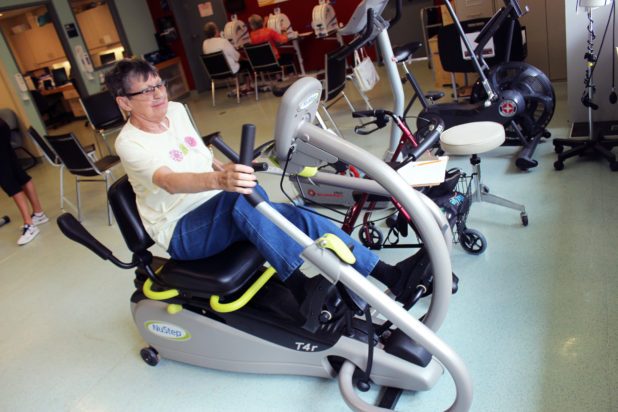General News
Rehab gives control back to those with COPD
August 3, 2017

First pulmonary rehabilitation program graduate Joan McKenzie pushes herself on the last day of the pilot July 27. / SARAH SOBANSKI Staff
By Sarah Sobanski
North Hastings Hospital is celebrating the first graduating class of its pulmonary rehabilitation program — and the program’s continuation.
The class of under 10 participants — referred to the program from area health professionals — all improved their quality of life and physical abilities. Physical test scores from a six minute walk test improved 15.4 per cent, with participants walking an extra two to 90 meters further than when they started. More than two thirds of participants reported an improvement in their general health and anxiety/depression. The same amount saw a 20 per cent improvement to their COPD.
“We wanted to get this going because there’s a big need for people with [Chronic Obstructive Pulmonary Disease] and pulmonary issues,” said physiotherapist with the program Melanie Dalley. “There’s a lot of incidences of COPD in the area and it’s a big concern with the emergency because it’s a lot of what they see in the emergency — so definitely something that’s being needed.”
Quinte Health Care North Hastings and the Bancroft Family Health Team first worked together to bring the program to the area in May. Respiratory therapist Lysanne Burnett, kinesiologist Alex Boyle, registered nurse Tammy Ives and Dalley monitor the program’s participants. It’s in the same room as the cardiac rehabilitation program, which began in 2015.
Funding for it has now been extended, following the successful pilot. It will run four times a year with patients attending the physiotherapy room in the hospital twice a week for eight weeks.
Dalley said having a pulmonary rehabilitation program in addition to the cardiac rehabilitation program is important because it’s in high demand.
“About four per cent of people have access to pulmonary rehab when it should be accessible to everybody,” said Dalley. “This is a pretty big deal because people don’t have access to it and we’ve got it in Bancroft.”
One of the main focuses of the program is exercise. Participants do weight training, cardiovascular exercise and resistance training.
“When you get short of breath you don’t want to exercise because you just can’t breathe and so you end up getting in this really bad cycle of can’t breathe, stop moving. Now that I’m stopping moving I really can’t breathe,” said Dalley. “It just keeps getting worse and worse. The whole point of this is to stop the cycle.”
Dalley explained maintaining a regular workout routine and staying physically fit helps the body use oxygen more efficiently. The program also focuses on breathing techniques, energy conservation — such as knowing your body’s schedule and when you get tired to plan accordingly — and education about the disease and the medications used to treat it. She said the better people understand what’s happening to them, the easier it is to slow the progression of pulmonary illnesses and CODP.
“A lot of people think, ‘I can’t breathe I better run to the hospital,’ and often times you can learn some techniques that you can do at home that can actually help to control your shortness of breath and you may not need to get to the hospital.”
Bancroft This Week attended the last class in the program July 27 to see how the participants were fairing. Each said they had improved.
“I just think it’s a really good thing,” said participant Gail Robinson. “There are lots of people who need it and haven’t had it. There are lots of people who have health issues, probably lots of them have breathing issues.”
Tony Youdale also found the program “very helpful” and said it was good for him to keep moving. He said he’s 81 and he wants to combat “things starting to slow down.”
The next program will begin in September. Dalley said anyone wanting to attend the program should talk to his or her family doctor to be referred. Anyone looking for more information or to be referred can also call Tammy Ives at the Bancroft Family Health Team: 613-332-1565 ex. 242.
“I think it’s been needed for a long time. It’s one of those things its really hard to get funding for any of these types of programs even though the literature is there to say they’re just as effective or more effective than just basically giving medication and treating it as a primary prevention. This is treating people before it happens,” said Dalley. “It’s one of those things that’s been proven over and over and over.”

















